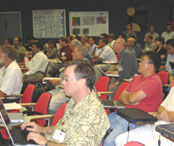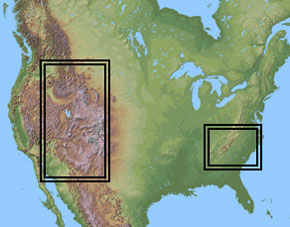GEON Applications Research Focuses on Rocky Mountain and Mid-Atlantic Testbeds
|
8.31.04 -- Applications work discussed at the recent GEON All-Hands Meeting focuses on two testbeds, CREATOR (described by Krishna Sinha, a geologist from Virginia Tech) and DYSCERN (described by Randy Keller, a geophysicist from the University of Texas at El Paso).
"As a geologist," said Sinha, "I'm looking for new ways to understand the earth. Representing the earth in 3D is a significant challenge, but NSF has recognized this and launched the EARTHSCOPE initiative," which is major project to study the Earth under the US.
Geologists try to acquire and interpret data to understand processes that have generated a certain data. They no longer want to just look at a rock record, but rather they want to know what is it, where is it, when was it formed, and especially why? "We want to develop a process ontology," said Sinha with a smile, admitting he'd been a faculty member for a long time and, until recently, "ontology" had not been part of his vocabulary.
CREATOR stands for "CRustal Evolution: AnaTomy of an ORogen" and focuses on the Appalachians in the mid-Atlantic. An Appalachian Orogen is a continental-scale mountain belt that provides a geologic template. "Rocks at the surface preserve information in 3D plus the fourth dimension of time," said Sinha. 'The Appalachians themselves represent 1,000 million years of activity not to mention scales of 100 microns to 100 kilometers. So we need to be able to integrate data across vast time and distance scales."
|
The DYSCERN testbed is studying the dynamics, structure, and Cenozoic evolution of the Rocky Mountains. Keller agreed with Sinha that scale is critical. "We're starting with the surface, but there's lots of important detail that propagates down. Our ultimate goal is to develop a fully integrated, 4-D model of the Earth in which as many physical properties as possible have been measured with time variations when possible." He described the "CD-ROM" project, which stands for Continental Dynamics of the ROcky Mountains, in which 20 co-investigators are studying the correlations between deep structure to surface structure of the Earth in this part of the US and showed how GEON has helped in the final integrated analysis of the diverse data set developed in this project.


